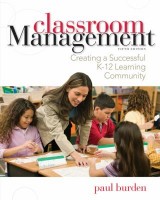 Author: Paul R. Burden
Author: Paul R. Burden
Publisher: Wiley – 297 pages
Book Review by: Krishnan Ramamurthy
This is the latest edition of a book that has become very popular among educators. It is thorough in its coverage and easy to understand, as it is written in plan everyday language. We had also reviewed the fourth edition of this classic in these pages online.
Written and updated by Paul R. Burden, an assistant dean and professor in the College of Education at Kansas State University in Manhattan, Kansas, this book covers topics ranging from motivating students to learn, to dealing with challenging and violent students, and many other issues a teacher faces during the school term in classes ranging from kindergarten to the 12th grade.
To emphasize the thoroughness of this book, I simply present to you an overview of its contents. I also present to you the organization of material in each chapter. Its 13 chapters cover the following topics (arranged alphabetically, not as organized in the Contents section):
- Choosing rules and procedures
- Collaborating with colleagues and families
- Communication skills for teaching
- Dealing with challenging and violent students
- Helping students with special needs
- Knowing your diverse students
- Maintaining appropriate student behavior
- Models of discipline
- Motivating students to learn
- Planning and conducting instruction
- Preparing for the school year
- Responding to inappropriate behavior
- Understanding management and discipline in the classroom
This latest edition contains a new chapter, on communication skills for teaching (chapter 6) and a feature called Classroom Case Study in each chapter, and numerous additional sections in various chapters.
The well-organized sections in each chapter include: Chapter Objectives, Chapter Outline, and various topics of study. These topics often have enumerated subtopics to sort of make the material more easily digestible in smaller bites.
For example, in a topic in chapter three entitled Making Management Preparations, you will find a list of 13 enumerated subtopics: the school environment, support materials, filing system, classroom procedures, classroom helpers, class lists and rosters, school/home communication, birthdays and other celebrations, distributing textbooks, room identification, room arrangement, seat selections and arrangements, and room decoration.
Occasionally, a Voices from the Classroom section appears in a chapter, in which teachers share their real-life insights on various issues. To help the student retain the material in his or her mind, at the end of each chapter are found sections entitled Major Concepts, Discussion/Reflective Questions, Suggested Activities, a Further Reading list, and Technology Resources.
Paul R. Burden is an experienced educator. He has taught courses on classroom management and discipline, foundations of education, instructional leadership, and teaching methods. He was a middle-level science teacher in Buffalo, New York prior to earning a doctoral degree at Ohio State University and becoming an assistant dean and professor at the College of Education at Kansas State University.
He has received several awards for teaching and has authored other books. He received the Outstanding Undergraduate Teaching Award from Kansas State University and the Distinguished Service Award from the National Staff Development Council. He authored Methods for Effective Teaching in 2013; Countdown to the First Day of School in 2006; Powerful Classroom Management Strategies and Motivating Students to Learn in 2000; and Establishing Career Ladders in 1987.
This is an excellent book on classroom management that is thorough in coverage, with lucid writing, well-laid out material, helpful sections, and real-life tips and insight from teachers. Moreover, this book is based on research studies that revealed what approaches to, and methods of, teaching work and which ones do not.







